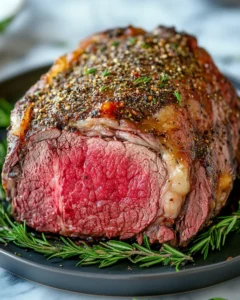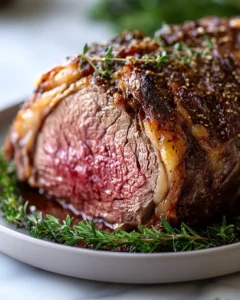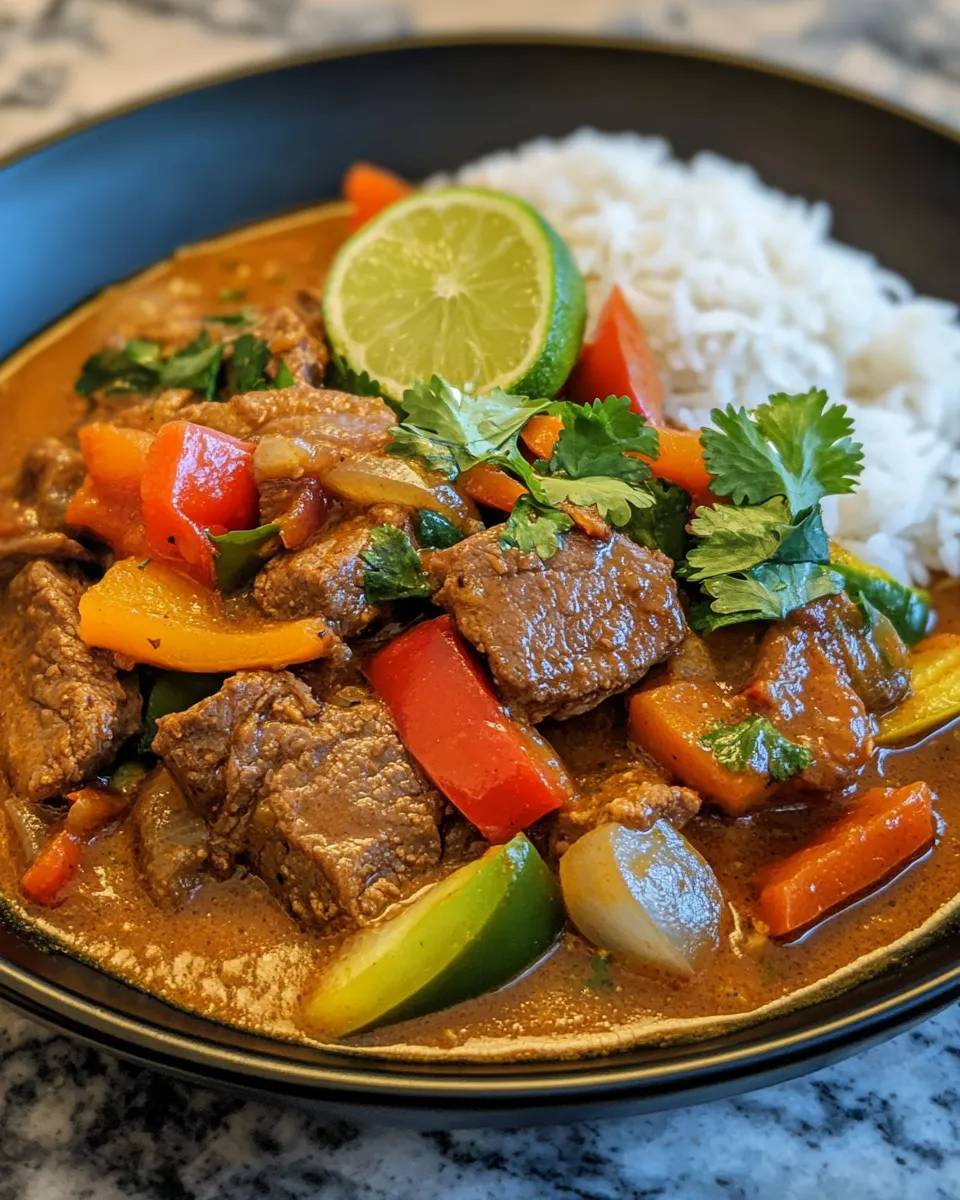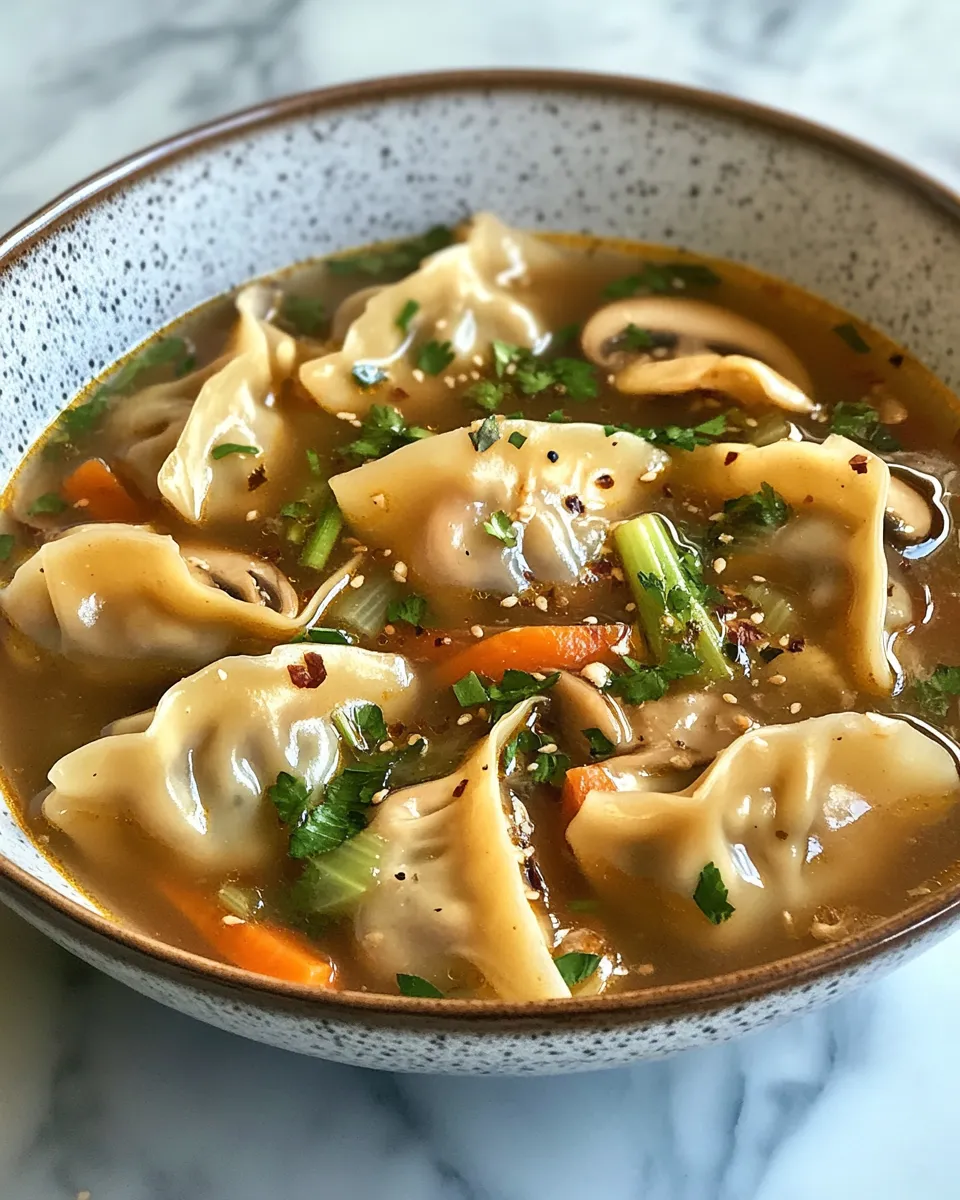There’s something undeniably special about a perfectly cooked prime rib roast. Whether it’s a celebratory holiday feast, a cozy weekend gathering with family, or a Sunday dinner that deserves an extra touch of elegance, this recipe delivers a centerpiece that will impress any table. The aroma of a slow-roasted prime rib filling your kitchen is enough to make anyone pause and take notice, signaling a meal worth savoring.
This recipe is inspired by the classic Sunday roasts of old, where family and friends gathered around the table, sharing stories and laughter while a succulent roast took center stage. The secret lies in the seasoning, the precise roasting method, and the patience to let the meat reach its perfect doneness. Every bite promises a juicy, flavorful experience that celebrates the rich, natural taste of beef.
Ingredients
-
1 (5-6 lb) prime rib roast, bone-in
-
4 cloves garlic, minced
-
2 tablespoons olive oil
-
2 tablespoons sea salt
-
1 tablespoon freshly ground black pepper
-
1 tablespoon fresh rosemary, finely chopped
-
1 tablespoon fresh thyme, finely chopped
-
1 teaspoon onion powder
-
1 teaspoon smoked paprika
-
Optional: fresh herbs for garnish (rosemary or thyme sprigs)
Directions
-
Prepare the Prime Rib: Remove the roast from the refrigerator at least 2 hours before cooking to allow it to come to room temperature. This ensures even cooking and better flavor. Pat the meat dry with paper towels.
-
Preheat the Oven: Set your oven to 450°F (230°C) to create a perfect sear at the beginning of roasting.
-
Season the Roast: In a small bowl, combine garlic, olive oil, salt, black pepper, rosemary, thyme, onion powder, and smoked paprika to create a flavorful rub. Rub this mixture evenly over the entire surface of the roast, making sure to coat all sides thoroughly.
-
Roast at High Heat: Place the prime rib, bone-side down, on a rack in a roasting pan. Insert an oven-safe meat thermometer into the thickest part of the meat, away from the bone. Roast in the preheated oven for 20 minutes to develop a rich, flavorful crust.
-
Reduce Oven Temperature: After the initial sear, lower the oven temperature to 325°F (160°C) and continue roasting until the internal temperature reaches your desired level of doneness:
-
Rare: 120-125°F (49-52°C)
-
Medium Rare: 130-135°F (54-57°C)
-
Medium: 140-145°F (60-63°C)
Roast times will vary depending on the size of your roast, but expect about 15-20 minutes per pound at the lower temperature.
-
-
Rest the Meat: Remove the roast from the oven and transfer it to a cutting board. Tent loosely with foil and let it rest for at least 20 minutes. Resting allows the juices to redistribute, ensuring every slice is tender and juicy.
-
Carve and Serve: Using a sharp carving knife, slice the roast between the bones into thick, succulent pieces. Arrange on a serving platter and garnish with fresh herbs if desired. Serve with your favorite sides such as roasted vegetables, mashed potatoes, or a fresh green salad.
Prep Time: 15 minutes
Cook Time: 2-2.5 hours
Total Time: 2 hours 15 minutes – 2 hours 45 minutes
Yield: Serves 6-8 people
Tips for the Juiciest Prime Rib
-
Choose the Right Cut: For maximum flavor and tenderness, select a prime rib roast with good marbling. Marbling ensures the meat stays juicy and flavorful during roasting.
-
Room Temperature Meat: Allowing the meat to sit at room temperature before cooking helps it cook more evenly, preventing a cold center.
-
Season Generously: Don’t skimp on seasoning. A robust rub enhances the natural flavor of the beef and creates a delicious crust.
-
Use a Thermometer: Investing in a good oven-safe thermometer takes the guesswork out of cooking and guarantees perfect doneness.
-
Rest Before Carving: Resting is crucial. Cutting too soon allows the juices to escape, leaving your roast less tender.
Serving Suggestions
A prime rib roast is a showstopper, and pairing it with complementary sides elevates the entire meal. Consider serving with:
-
Creamy mashed potatoes or garlic roasted potatoes
-
Oven-roasted seasonal vegetables like carrots, Brussels sprouts, or asparagus
-
A light, fresh salad with lemon vinaigrette to balance the richness of the meat
-
Warm, freshly baked bread or rolls for mopping up juices
For an extra touch of indulgence, drizzle pan juices or a simple au jus over the sliced meat. These juices, infused with herbs and the natural flavor of the beef, bring every bite to life.
Why This Prime Rib Stands Out
Many roast recipes can leave beef dry or unevenly cooked, but this method emphasizes a combination of high-heat searing followed by gentle roasting. The high initial temperature locks in juices and forms a flavorful crust, while the slow, steady finish ensures even cooking throughout. Pair this technique with a simple but aromatic herb rub, and you have a prime rib roast that’s both flavorful and tender—perfect for making any occasion memorable.
Perfect for Every Occasion
This oven-baked prime rib roast isn’t just for holidays. It shines at family dinners, celebratory gatherings, or even a special weekend meal. The impressive presentation and mouthwatering aroma make it a centerpiece that’s hard to resist. Even guests who aren’t usually beef enthusiasts will be drawn in by the juicy, savory perfection of each slice.
Additionally, the recipe’s simplicity ensures it’s accessible even to home cooks who want to achieve a restaurant-quality roast without the stress. With straightforward steps and clear guidance on temperatures and timing, you can confidently serve a prime rib roast that rivals any high-end steakhouse.
Storage and Leftovers
Leftover prime rib can be just as enjoyable the next day. Store any leftover slices in an airtight container in the refrigerator for up to 3-4 days. To reheat without drying out the meat, wrap slices in foil and warm gently in the oven at 300°F (150°C) until heated through.
Leftover prime rib is also versatile in other dishes. Slice thinly and use in sandwiches, add to salads, or chop and incorporate into hearty beef stews. The flavorful, tender meat ensures that nothing goes to waste and that every meal remains satisfying.
Frequently Asked Questions
Can I cook the prime rib without the bone?
Absolutely! Boneless prime rib can be used if you prefer, and it can still produce a delicious, tender roast. However, bone-in roasts tend to have an advantage when it comes to flavor and even cooking. The bone acts as a natural insulator, helping the meat cook more slowly and evenly while also adding depth to the flavor. If you decide to use a boneless roast, you may need to slightly adjust your cooking time since the heat will penetrate the meat differently. Keep a close eye on the internal temperature, and consider using a meat thermometer to ensure you hit the perfect level of doneness. Even without the bone, a well-seasoned boneless prime rib can still impress your guests and yield juicy, flavorful slices.
How do I know when the roast is done?
One of the most common challenges when cooking prime rib is knowing exactly when it’s perfectly cooked. The best way to ensure this is by using an oven-safe meat thermometer. Insert the thermometer into the thickest part of the roast, making sure to avoid touching the bone, as this can give an inaccurate reading. For those who prefer rare meat, aim for an internal temperature of 120–125°F (49–52°C). Medium-rare, which is the most popular doneness for prime rib, should reach 130–135°F (54–57°C). Medium doneness falls between 140–145°F (60–63°C). Remember that the roast will continue to cook slightly after you remove it from the oven, so it’s best to take it out a few degrees below your target temperature. Using a thermometer ensures you won’t overcook or undercook your prime rib, giving you consistently juicy results.
Can I prepare the roast ahead of time?
Yes! Preparing the roast ahead of time can actually enhance the flavor. Many home cooks prefer to season the prime rib a day in advance and refrigerate it overnight. This allows the seasonings to penetrate the meat more deeply, creating a richer, more flavorful crust when it’s roasted. On the day of cooking, remove the roast from the refrigerator and let it sit at room temperature for about two hours before putting it in the oven. Bringing the meat to room temperature helps it cook more evenly, preventing cold spots in the center and ensuring a perfect roast from edge to edge.
What sides pair best with prime rib?
Prime rib is a luxurious main dish, and the right sides can elevate it even further. Classic pairings include roasted vegetables, creamy mashed potatoes, or cheesy au gratin potatoes. Fresh green salads with light dressings balance the richness of the beef, while sauces like horseradish cream or a simple beef jus can add an extra layer of flavor. Consider seasonal vegetables such as roasted carrots, asparagus, or Brussels sprouts for color and texture. These sides complement the tender, juicy prime rib perfectly, creating a well-rounded and memorable meal for any occasion.
Conclusion
The Best Juicy Oven-Baked Prime Rib Roast Ever is more than just a meal—it’s an experience. From the moment it enters the oven to the final slice served at the table, it brings a sense of celebration and warmth. The combination of a perfectly seasoned crust, juicy interior, and elegant presentation makes it a dish that’s hard to forget.
By following this recipe, you can achieve restaurant-quality results at home, impress your guests, and create memories around the dinner table. Whether it’s a holiday feast, a special family gathering, or simply a weekend treat, this prime rib roast promises satisfaction with every bite. Let your kitchen be filled with the irresistible aroma of slow-roasted perfection, and watch as your guests savor each tender, flavorful slice.
Print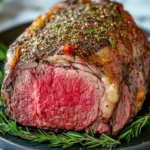
The Best Juicy Oven-Baked Prime Rib Roast Ever
- Total Time: 2 hours 15 minutes – 2 hours 45 minutes
- Yield: Serves 6–8 1x
Description
There’s something magical about a perfectly cooked prime rib roast. Whether it’s a festive holiday feast, a cozy weekend family dinner, or a special celebration, this roast is the centerpiece that steals the show. The rich aroma of a slow-roasted prime rib filling your kitchen sets the tone for an unforgettable meal.
Inspired by classic Sunday roasts, this recipe honors a tradition where family and friends gather around the table to enjoy not just a meal, but an experience. The combination of a flavorful herb rub, a high-heat sear, and slow roasting ensures each slice is tender, juicy, and full of flavor. This is a roast that makes any occasion feel truly special.
Ingredients
-
1 (5-6 lb) prime rib roast, bone-in
-
4 cloves garlic, minced
-
2 tablespoons olive oil
-
2 tablespoons sea salt
-
1 tablespoon freshly ground black pepper
-
1 tablespoon fresh rosemary, finely chopped
-
1 tablespoon fresh thyme, finely chopped
-
1 teaspoon onion powder
-
1 teaspoon smoked paprika
-
Optional: fresh herbs for garnish (rosemary or thyme sprigs)
Instructions
-
Remove the roast from the refrigerator at least 2 hours before cooking to allow it to come to room temperature. Pat dry with paper towels.
-
Preheat the oven to 450°F (230°C) for an initial high-heat sear.
-
Combine garlic, olive oil, salt, black pepper, rosemary, thyme, onion powder, and smoked paprika to make a rub. Coat the roast evenly with the mixture.
-
Place the prime rib, bone-side down, on a rack in a roasting pan. Insert an oven-safe meat thermometer into the thickest part of the meat, avoiding the bone.
-
Roast at 450°F (230°C) for 20 minutes to create a crust.
-
Reduce oven temperature to 325°F (160°C) and continue roasting until the internal temperature reaches your desired doneness:
-
Rare: 120-125°F (49-52°C)
-
Medium Rare: 130-135°F (54-57°C)
-
Medium: 140-145°F (60-63°C)
-
-
Remove the roast from the oven and tent loosely with foil. Let it rest for at least 20 minutes.
-
Carve between the bones into thick slices. Arrange on a serving platter and garnish with fresh herbs if desired.
Notes
-
For the juiciest roast, choose a cut with good marbling.
-
Bring the meat to room temperature before cooking for even doneness.
-
Use a meat thermometer to avoid overcooking.
-
Resting the meat before carving allows juices to redistribute.
-
Serve with roasted vegetables, mashed potatoes, au jus, or horseradish sauce for a complete meal.
- Prep Time: 15 minutes
- Cook Time: 2–2.5 hours


